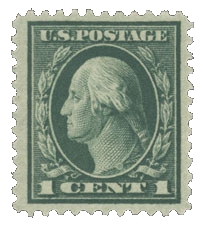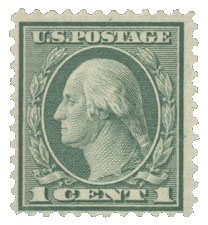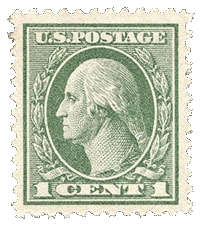
1¢ Washington Head
Denomination in Numerals
Perf 11

Perf 11
Flat Plate

Perf 11
Rotary Press

Perf 11
Offset
Watermark Check This stamp does not need to be checked for watermark. If it is perf 11 on at least two adjacent sides it is unwatermarked. However, your work is not done! You must determine if the stamp was printed using the flat plate, rotary press or offset method. If you are unsure how to do this, we have included details on how this is done on the Printing Methods for the Washington Franklins page
| Printing Method | Color | Size of Frame | Number |
| Flat Plate | Green or yellow-green | 19 x 22 mm | 498 |
| Rotary Press "sheet waste" | Dark Gray Green | 19 x 22.5 mm (taller) | 544(see caution below) |
| Rotary Press coil waste | Green or yellow-green | 19.5-20 x 22 mm (wider) | 545 (see caution below) |
| Offset Press | grayish green | 19 x 22 mm | 525 |
Caution
The 1¢ rotary press "sheet waste" and "coil waste" stamps, Number 544 and 545, are sometimes faked.
Number 544 is one of the great rarities of the 20th century U.S. stamps, estimated at fewer than 20 unused copies with most of these contained in blocks or strips of four. Only the most brazen of forgers tries to fake one of these, since the stamp is so valuable the cost of certification is meaningless in comparison to the value of the stamp. There is only one reason anyone would sell one of these without a certificate, they are absolutely certain it is not the 544.
It is also possible to confuse it with the far more common, yet still rare Number 545; the 544 is taller than any given flat plate stamp and the 545 is wider. Fakes are made from the rotary coil stamp, Number 486, or the experimental 10 x 11 rotary stamp, Number 542. Both stamps are the wrong color - the Number 544 is dark gray green - and therefore make poor fakes.
Number 545 may be faked by trimming the perforations at left and right on the rotary coil stamp Number 490 and then adding 11 gauge perforations to all four sides. These fakes will look small with narrow margins and the perforations will prove suspect. Similar fakes can be made from Number 538, but these will be even smaller. There was no imperforate 1¢ rotary stock, so fakes made by adding perforations to the imperforate stamp do not exist. It is also possible to alter the perforations on the perf 10 experimental stamp, Number 543, but the stamp will be too tall and not wide enough, since the direction of stretch on the 543 is in the vertical direction.
Particularly large examples of the common Number 498 may cause confusion, but the design of the Number 498 will never measure a full 19.5 mm wide, while the 545 must. This stamp is expensive enough that it should be certified before buying or selling.